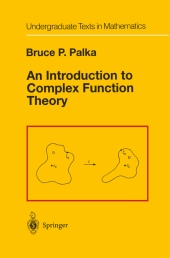 Neuerscheinungen 2012Stand: 2020-01-07 |
Schnellsuche
ISBN/Stichwort/Autor
|
Herderstraße 10
10625 Berlin
Tel.: 030 315 714 16
Fax 030 315 714 14
info@buchspektrum.de |

Bruce P. Palka
An Introduction to Complex Function Theory
2012. xvii, 560 S. XVII, 560 p. 235 mm
Verlag/Jahr: SPRINGER, BERLIN 2012
ISBN: 1-461-26967-9 (1461269679)
Neue ISBN: 978-1-461-26967-0 (9781461269670)
Preis und Lieferzeit: Bitte klicken
This book provides a rigorous yet elementary introduction to the theory of analytic functions of a single complex variable. While presupposing in its readership a degree of mathematical maturity, it insists on no formal prerequisites beyond a sound knowledge of calculus. Starting from basic definitions, the text slowly and carefully develops the ideas of complex analysis to the point where such landmarks of the subject as Cauchy´s theorem, the Riemann mapping theorem, and the theorem of Mittag-Leffler can be treated without sidestepping any issues of rigor. The emphasis throughout is a geometric one, most pronounced in the extensive chapter dealing with conformal mapping, which amounts essentially to a "short course" in that important area of complex function theory. Each chapter concludes with a wide selection of exercises, ranging from straightforward computations to problems of a more conceptual and thought-provoking nature.
´I The Complex Number System.- 1 The Algebra and Geometry of Complex Numbers.- 1.1 The Field of Complex Numbers.- 1.2 Conjugate, Modulus, and Argument.- 2 Exponentials and Logarithms of Complex Numbers.- 2.1 Raising e to Complex Powers.- 2.2 Logarithms of Complex Numbers.- 2.3 Raising Complex Numbers to Complex Powers.- 3 Functions of a Complex Variable.- 3.1 Complex Functions.- 3.2 Combining Functions.- 3.3 Functions as Mappings.- 4 Exercises for Chapter I.- II The Rudiments of Plane Topology.- 1 Basic Notation and Terminology.- 1.1 Disks.- 1.2 Interior Points, Open Sets.- 1.3 Closed Sets.- 1.4 Boundary, Closure, Interior.- 1.5 Sequences.- 1.6 Convergence of Complex Sequences.- 1.7 Accumulation Points of Complex Sequences.- 2 Continuity and Limits of Functions.- 2.1 Continuity.- 2.2 Limits of Functions.- 3 Connected Sets.- 3.1 Disconnected Sets.- 3.2 Connected Sets.- 3.3 Domains.- 3.4 Components of Open Sets.- 4 Compact Sets.- 4.1 Bounded Sets and Sequences.- 4.2 Cauchy Sequences.- 4.3 Compact Sets.- 4.4 Uniform Continuity.- 5 Exercises for Chapter II.- III Analytic Functions.- 1 Complex Derivatives.- 1.1 Differentiability.- 1.2 Differentiation Rules.- 1.3 Analytic Functions.- 2 The Cauchy-Riemann Equations.- 2.1 The Cauchy-Riemann System of Equations.- 2.2 Consequences of the Cauchy-Riemann Relations.- 3 Exponential and Trigonometric Functions.- 3.1 Entire Functions.- 3.2 Trigonometric Functions.- 3.3 The Principal Arcsine and Arctangent Functions.- 4 Branches of Inverse Functions.- 4.1 Branches of Inverse Functions.- 4.2 Branches of the pth-root Function.- 4.3 Branches of the Logarithm Function.- 4.4 Branches of the ?-power Function.- 5 Differentiability in the Real Sense.- 5.1 Real Differentiability.- 5.2 The Functions fz and fz.- 6 Exercises for Chapter III.- IV Complex Integration.- 1 Paths in the Complex Plane.- 1.1 Paths.- 1.2 Smooth and Piece wise Smooth Paths.- 1.3 Parametrizing Line Segments.- 1.4 Reverse Paths, Path Sums.- 1.5 Change of Parameter.- 2 Integrals Along Paths.- 2.1 Complex Line Integrals.- 2.2 Properties of Contour Integrals.- 2.3 Primitives.- 2.4 Some Notation.- 3 Rectiflable Paths.- 3.1 Rectifiable Paths.- 3.2 Integrals Along Rectifiable Paths.- 4 Exercises for Chapter IV.- V Cauchy´s Theorem and its Consequences.- 1 The Local Cauchy Theorem.- 1.1 Cauchy´s Theorem For Rectangles.- 1.2 Integrals and Primitives.- 1.3 The Local Cauchy Theorem.- 2 Winding Numbers and the Local Cauchy Integral Formula.- 2.1 Winding Numbers.- 2.2 Oriented Paths, Jordan Contours.- 2.3 The Local Integral Formula.- 3 Consequences of the Local Cauchy Integral Formula.- 3.1 Analyticity of Derivatives.- 3.2 Derivative Estimates.- 3.3 The Maximum Principle.- 4 More About Logarithm and Power Functions.- 4.1 Branches of Logarithms of Functions.- 4.2 Logarithms of Rational Functions.- 4.3 Branches of Powers of Functions.- 5 The Global Cauchy Theorems.- 5.1 Iterated Line Integrals.- 5.2 Cycles.- 5.3 Cauchy´s Theorem and Integral Formula.- 6 Simply Connected Domains.- 6.1 Simply Connected Domains.- 6.2 Simple Connectivity, Primitives, and Logarithms.- 7 Homotopy and Winding Numbers.- 7.1 Homotopic Paths.- 7.2 Contractible Paths.- 8 Exercises for Chapter V.- VI Harmonic Functions.- 1 Harmonic Functions.- 1.1 Harmonic Conjugates.- 2 The Mean Value Property.- 2.1 The Mean Value Property.- 2.2 Functions Harmonic in Annuli.- 3 The Dirichlet Problem for a Disk.- 3.1 A Heat Flow Problem.- 3.2 Poisson Integrals.- 4 Exercises for Chapter VI.- VII Sequences and Series of Analytic Functions.- 1 Sequences of Functions.- 1.1 Uniform Convergence.- 1.2 Normal Convergence.- 2 Infinite Series.- 2.1 Complex Series.- 2.2 Series of Functions.- 3 Sequences and Series of Analytic Functions.- 3.1 General Results.- 3.2 Limit Superior of a Sequence.- 3.3 Taylor Series.- 3.4 Laurent Series.- 4 Normal Families.- 4.1 Normal Subfamilies of C(U).- 4.2 Equicontinuity.


